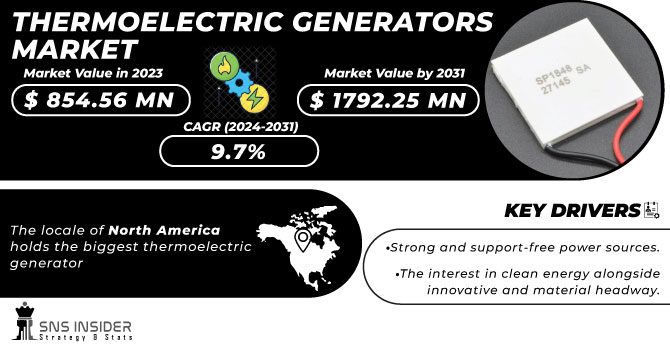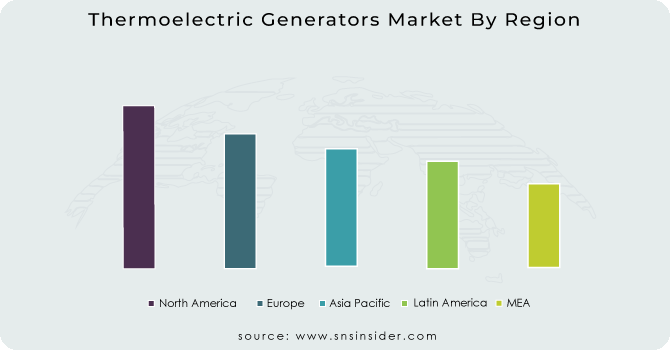Thermoelectric Generators Market Report Scope & Overview:
The Thermoelectric Generators Market Size was esteemed at USD 854.56 million in 2023 and is supposed to arrive at USD 1792.25 million by 2031 and develop at a CAGR of 9.7% over the forecast period 2024-2031.
Thermoelectric materials create power straightforwardly from the intensity by changing over temperature contrasts into electric voltage. These materials should have both high electrical conductivity and low warm conductivity to be great thermoelectric materials. Having low warm conductivity guarantees that when one side is made hot, the opposite side stays cold, which assists with creating a huge voltage while in a temperature slope.

To get more information on Thermoelectric Generators Market - Request Free Sample Report
The proportion of the extent of electrons stream because of temperature contrast across that material is given by the Seebeck coefficient. For a long time, the really three semiconductors are known to have both low warm conductivity and high-power factors were bismuth telluride, lead telluride, and silicon germanium. A portion of these materials has fairly intriguing components which makes them costly.
Today, the warm conductivity of semiconductors can be brought down without influencing their high electrical properties utilizing nanotechnology. This can be accomplished by making nanoscale elements like particles, wires, or connection points in mass semiconductor materials. Be that as it may, the assembling cycles of nano-materials are as yet tested. A thermoelectric circuit made out of materials of various Seebeck coefficients, designed as a thermoelectric generator.
Thermoelectric generators are all-strong state gadgets that require no liquids for fuel or cooling, making them non-direction subordinate considering use in zero-gravity or remote ocean applications. The strong state configuration considers activity in extreme conditions. Thermoelectric generators have no moving parts which produces a more solid gadget that doesn't need upkeep for significant stretches. The sturdiness and ecological strength have made thermoelectrics a #1 for NASA's profound space voyagers among different applications. One of the critical benefits of thermoelectric generators beyond such particular applications is that they might be coordinated into existing advancements to help proficiency and diminish natural effects by creating usable power from squandered heat.
Market Dynamics:
Driving Factors:
-
Strong and support-free power sources.
-
The interest in clean energy alongside innovative and material headway.
Restraining Factors:
-
The productivity force of the generator is exceptionally low.
Opportunities:
-
Progressing research and advancement to update TEG execution.
-
Emerge in extra cash and an expansion in industrialization.
Challenges:
-
Presence of noticeable substitutes and primary intricacy.
Impact of Covid-19:
The coronavirus pandemic has impacted the worldwide economy for a gigantic scope. This is because of tasks in different areas. A portion of the ventures utilizing this generator is the medical care areas, fabricating unit, marine, and protection field.
Coronavirus prompts the downfall of power which has turned into a difficult figure in the power business. A few organizations are working at a decent speed to help different organizations. The public authority is doing whatever it takes and is put sending rules and guidelines to make up for the misfortune.
Market Estimations:
By Wattage:
Given Wattage, the thermoelectric generators market is sectioned into low power (<10 W), medium power (10-1 kW), and high power (> 1 kW). The power created by thermoelectric generators is exceptionally subject to the temperature applied to their plates. The low power (<10 W) section of the thermoelectric generators market is projected to develop at the most noteworthy CAGR during the estimated time frame. The expanded utilization of wearables and handheld shopper electronic gadgets is the significant driver for the development of the low-power section.
By Type:
Given the type into account the stream and intensity move cycle of the intensity source alongside the virus source, TEGs are sorted into single stage and multistage. The single-stage portion held a significant portion of the worldwide TEG market in 2020 and the multi-stage section will have the most noteworthy CAGR during the conjecture time frame.
By Temperature:
Given the temperature, the thermoelectric generators market is sectioned into low temperature (<80°C), medium temperature (80°-500°C), and high temperature (>500°C). These temperature ranges rely on the application that the thermoelectric generators utilized. By temperature, the low (<80°C) fragment of the thermoelectric generator (TEG) market is projected to enlist the most noteworthy CAGR of 11.2% during the gauge time frame. Severe regulations to diminish CO2 outflow have prompted the rising use of thermoelectric generators.
By Material:
Given the material, the thermoelectric generators market is sectioned into bismuth telluride, lead telluride, and others. The choice of the thermoelectric material is reliant upon the temperature range at which the material is utilized. As of now, bismuth telluride is the most broadly involved material as it has the most elevated figure of legitimacy and shows elite execution across applications. The Bismuth Telluride fragment of the thermoelectric generators (TEG) market is projected to enlist the most elevated CAGR during the estimated time frame.
By Component:
Given components, the thermoelectric generators market is sectioned into the heat source, thermoelectric module, cold side, and electric burden. These parts are made of materials like bismuth telluride, lead telluride, and others for better warm conductivity. The thermoelectric module fragment is projected to have the most noteworthy CAGR during the gauge time frame. Expanding utilization of productive materials for assembling thermoelectric modules helps request.
By Verticals:
Given Verticals, the thermoelectric generators market is sectioned into the car, aviation and protection, marine, modern, purchaser, medical services, oil and gas, mining, and media communications. The modern section is projected to record the most elevated development during the estimated time frame attributable to the reception of TEGs in smelters and impact heaters, and other compound handling applications.
By application:
Given the application, the thermoelectric generators market is sectioned into energy gathering, squander heat recuperation, direct power age, and co-age. The waste intensity recuperation application is supposed to lead the market for TEGs during the estimated time frame driven by the rising pattern of zap of vehicles. This pattern will assist with expanding the interest for TEGs, which produce power from the waste intensity from cars.
Key Market Segmentation
By Component
-
Heat Source
-
Thermoelectric Module
-
Cold Side
-
Electric Load
By Wattage
-
Low Power (<10W)
-
Medium Power (10-1 kW)
-
High Power (>1 kW)
By Application
-
Direct Power Generation
-
Co-generation
By Temperature:
-
Low (<80°C)
-
Medium (80°- 500°C)
-
High (> 500°C)
By Vertical:
-
Automotive
-
IC-Powered Vehicles
-
-
Aerospace &Defense
-
Aviation
-
Civil
-
Military
-
UAVs
-
-
Defense
-
Military Vehicles
-
Power Generators
-
Soldier Systems
-
-
-
Marine
-
Military Ships
-
Commercial Ships
-
-
Industrial
-
Chemical
-
Aluminum & Steel
-
Glass & Metal Casting
-
-
Consumer
-
Wearables
-
Consumer Electronics
-
-
Healthcare
-
Implantables
-
Wearables
-
-
Oil & Gas
-
Mining
-
Telecommunications
By Material:
-
Bismuth Telluride
-
Lead Telluride
-
Others
By Type:
-
Single Stage
-
Multistage
Regional Analysis:
-
North America
-
USA
-
Canada
-
Mexico
-
-
Europe
-
Germany
-
UK
-
France
-
Italy
-
Spain
-
The Netherlands
-
Rest of Europe
-
-
Asia-Pacific
-
Japan
-
south Korea
-
China
-
India
-
Australia
-
Rest of Asia-Pacific
-
-
The Middle East & Africa
-
Israel
-
UAE
-
South Africa
-
Rest of Middle East & Africa
-
-
Latin America
-
Brazil
-
Argentina
-
Rest of Latin America
-
The thermoelectric generator market is partitioned into North America, Europe, Asia Pacific, and Latin America. The locale of North America holds the biggest thermoelectric generator piece of the pie followed by Asia-Pacific, as would be considered normal for a worldwide venture at a high CAGR on the lookout. North America additionally covers the most noteworthy thermoelectric generator market income share during the conjecture time frame. The ascent popular for generators via car businesses will in general improve eco-friendliness and expands the industrialization in the market locale which in this manner drives the auto enterprises. This strength of North America will exist for a long time.

Need any customization research on Thermoelectric Generators Market - Enquiry Now
Key Players
The Major Players are Gentherm, Inc., II-VI Incorporated, Ferrotec Corporation, Laird PLC, Komatsu Limited, Yamaha Corporation, Evident Thermoelectrics, Tecteg, Alphabet Energy, Tellurex Corporation and Other Players.
Ferrotec Corporation-Company Financial Analysis

| Report Attributes | Details |
|---|---|
| Market Size in 2023 | US$ 854.56 Million |
| Market Size by 2031 | US$ 1792.25 Million |
| CAGR | CAGR of 9.7% From 2024 to 2031 |
| Base Year | 2023 |
| Forecast Period | 2024-2031 |
| Historical Data | 2020-2022 |
| Report Scope & Coverage | Market Size, Segments Analysis, Competitive Landscape, Regional Analysis, DROC & SWOT Analysis, Forecast Outlook |
| Key Segments | • By Component (Heat Source, Thermoelectric Module, Cold Side, Electric Load) • By Wattage (Low Power (<10W>1 kW) • By Application (Waste Heat Recovery, Energy Harvesting, Direct Power Generation, Co-generation) • By Temperature (Low (<80> 500°C)) • By Vertical (Automotive, Aerospace &Defense, Marine, Industrial, Consumer, Healthcare, Oil & Gas, Mining, Telecommunications) • By Material (Bismuth Telluride, Lead Telluride, Others) • By Type (Single Stage, Multistage) |
| Regional Analysis/Coverage | North America (USA, Canada, Mexico), Europe (Germany, UK, France, Italy, Spain, Netherlands, Rest of Europe), Asia-Pacific (Japan, South Korea, China, India, Australia, Rest of Asia-Pacific), The Middle East & Africa (Israel, UAE, South Africa, Rest of Middle East & Africa), Latin America (Brazil, Argentina, Rest of Latin America) |
| Company Profiles | Gentherm, Inc., II-VI Incorporated, Ferrotec Corporation, Laird PLC, Komatsu Limited, Yamaha Corporation, Evident Thermoelectrics, Tecteg, Alphabet Energy, and Tellurex Corporation. |
| DRIVERS | • Strong and support free power sources. • The interest in clean energy alongside innovative and material headway. |
| RESTRAINTS | • The productivity force of the generator is exceptionally low. |

